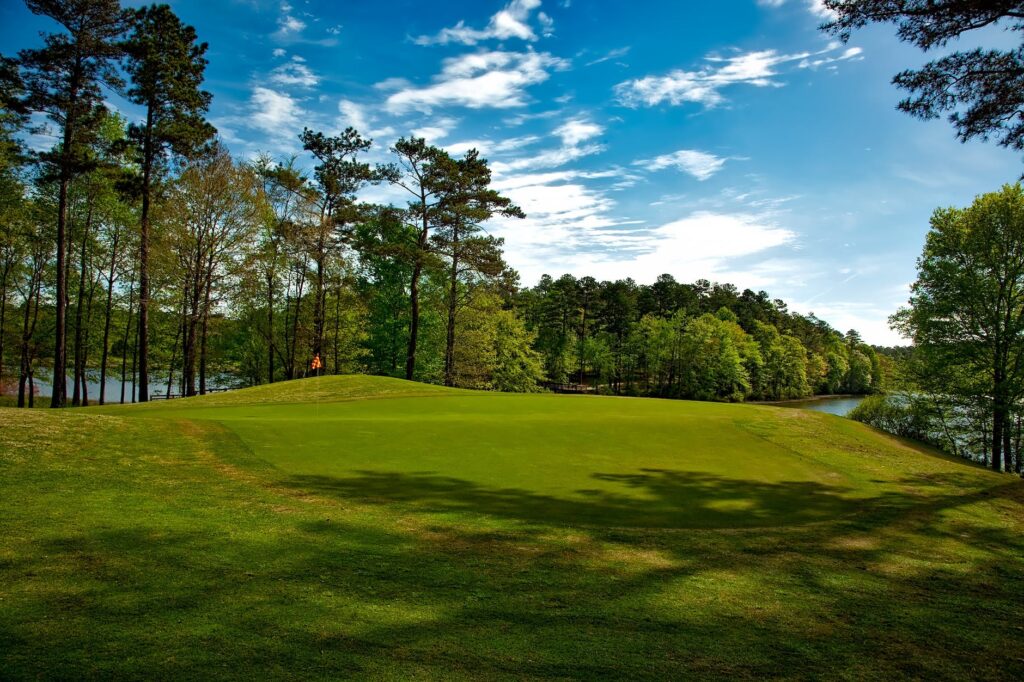Golf is a game of precision, skill, and strategy. But have you ever stopped to think about the grass beneath your feet? It’s not just a surface; it’s a vital part of the game. Different types of grass can affect everything from the roll of the ball to the swing of the club. In this guide, we’ll explore the various types of golf course grass and how to play on each one. So grab your clubs, and let’s get started!

Bermuda Grass
Characteristics
Bermuda grass is a favorite in warm climates like the southern United States. Known for its heat tolerance and ability to withstand heavy foot traffic, it’s a common choice for fairways and greens.
How to Play
Playing on Bermuda grass requires attention to the grain, which can affect the roll of the ball. Putting can be slower, so a firm stroke is often needed. In the rough, the dense texture can grab the club, so a sharp and precise swing is essential.
Maintenance and Care
Bermuda grass requires regular mowing and watering to maintain its dense and smooth texture. Proper fertilization and pest control are also vital to keep it in top condition.
Famous Courses with Bermuda Grass
Courses like TPC Sawgrass and Pebble Beach feature Bermuda grass, offering a unique playing experience.
Bentgrass
Characteristics
Bentgrass thrives in cooler climates and is known for its fine and smooth texture. It provides a consistent and true roll, making it a favorite for putting greens.
How to Play
Putting on bentgrass is often a joy for golfers, as the ball glides smoothly. The greens can be fast, so a gentle touch is needed. In the fairways, the soft texture allows for clean and crisp shots.
Maintenance and Care
Bentgrass requires careful maintenance, including regular mowing, watering, and aeration. It’s more susceptible to diseases, so proper care is essential.
Famous Courses with Bentgrass
Iconic courses like Augusta National and Oakmont Country Club feature bentgrass, providing a world-class playing experience.
Kentucky Bluegrass
Characteristics
Kentucky Bluegrass is known for its lush and beautiful appearance. It’s a cool-season grass that thrives in northern regions and provides a rich and dense playing surface.
How to Play
Playing on Kentucky Bluegrass requires a strong swing, especially in the rough. The dense texture can be challenging, so sharp and clean contact with the ball is essential.
Maintenance and Care
Kentucky Bluegrass requires regular watering and fertilization to maintain its vibrant color and density. Proper mowing and pest control are also vital.
Famous Courses with Kentucky Bluegrass
Courses like Bethpage Black feature Kentucky Bluegrass, offering a challenging and beautiful playing experience.
Zoysia Grass
Characteristics
Zoysia grass is known for its heat and drought tolerance. It provides a firm and dense playing surface, often used in fairways and tees in warmer regions.
How to Play
Playing on Zoysia requires adjustments for the firmness of the turf. The ball may bounce higher and roll further, so club selection and shot strategy are essential.
Maintenance and Care
Zoysia requires less water and fertilization compared to other grass types. Regular mowing and pest control are still essential to keep it in top condition.
Famous Courses with Zoysia Grass
Courses like Trinity Forest Golf Club feature Zoysia grass, providing a unique and firm playing experience.
Paspalum Grass
Characteristics
Paspalum grass is a salt-tolerant grass often found in coastal regions. It thrives in sandy soils and provides a soft and smooth playing surface.
How to Play
Playing on Paspalum requires a softer touch, especially on the greens. Putting may be slower, so a firm stroke is often needed. The soft texture provides a cushioned feel for approach shots.
Maintenance and Care
Paspalum requires regular watering and fertilization, especially in sandy soils. Proper mowing and pest control are also vital to maintain its soft and smooth texture.
Famous Courses with Paspalum Grass
Courses like The Ocean Course at Kiawah Island feature Paspalum grass, offering a coastal and unique playing experience.
Fescue Grass
Characteristics
Fescue grass is often used in links-style courses and provides a natural and rugged look. It’s drought-resistant and thrives in sandy and coastal regions.
How to Play
Playing on Fescue can be tricky, especially in the rough. The wispy and fine texture can snag the club, so a sweeping motion is often more effective. On the fairways, the ball may sit up higher, allowing for easier contact.
Maintenance and Care
Fescue requires less water and fertilization compared to other grass types. Regular mowing and pest control are still essential to maintain its natural and rugged appearance.
Famous Courses with Fescue Grass
Courses like Bandon Dunes feature Fescue grass, providing a true links-style playing experience.
Ryegrass
Characteristics
Ryegrass is a cool-season grass used in overseeding to keep courses green during the winter. It’s lush and provides a soft and sticky playing surface.
How to Play
Playing on Ryegrass requires a smooth and controlled swing to avoid getting caught in the sticky texture. Putting may be slower, so a firm stroke is needed.
Maintenance and Care
Ryegrass requires regular watering and fertilization to maintain its lush appearance. Proper mowing and pest control are also vital.
Famous Courses with Ryegrass
Courses like Torrey Pines feature Ryegrass, providing a lush and beautiful playing experience.
Tips for Playing on Different Grass Types
Study the Course
Before playing, study the course and understand the types of grass used. Knowing the characteristics of the grass can help you plan your shots and strategy.
Adjust Your Equipment
Different grass types may require adjustments to your equipment, such as club selection and ball type. Experiment and find what works best for you.
Practice on Similar Grass
If possible, practice on similar grass types before playing a new course. Familiarity with the grass can boost your confidence and performance.
Respect the Course
Proper golf etiquette includes respecting the course and the grass. Repair divots, rake bunkers, and follow course rules to maintain the beauty and integrity of the grass.
Conclusion
The world of golf course grass is diverse and fascinating. From the heat-tolerant Bermuda to the fine-textured Bentgrass, each type offers unique challenges and opportunities. Understanding these differences and learning how to play on each type can enhance your game and enjoyment of this beautiful sport.
So next time you step onto the course, take a moment to appreciate the grass beneath your feet. It’s not just a surface; it’s a vital part of the game. Whether you’re playing on the rugged links of Scotland or the lush fairways of Florida, the grass is an essential and beautiful part of golf. Happy golfing! 🏌️♂️

